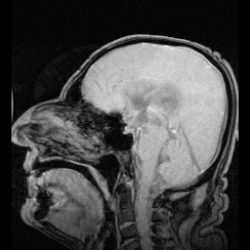Phase contrast MRI
The study of CSF flow became one of Phase-contrast MRI's major applications. The key to Phase-contrast MRI (PC-MRI) is the use of a bipolar gradient. [4] A bipolar gradient has equal positive and negative magnitudes that are applied for the same time duration. The bipolar gradient in PC-MRI is put in a sequence after RF excitation but before data collection during the echo time of the generic MRI modality. The bipolar lobe must be applied in all three axes to image flow in all three directions.
Bipolar gradient
The basis of the bipolar gradient in PC-MRI is that when using this gradient to change frequencies, there will be no phase shift for the stationary protons because they will experience equal positive and negative magnitudes. [4] However, the moving protons will undergo various degrees of phase shift because, along the gradient direction, their locations are constantly changing. This notion can be applied to monitor protons that are moving through a plane. From the phase contrast, the floating protons can be detected. In the equation for determining the phase, local susceptibility influence is not removed by this bipolar gradient. Thus, it is necessary to invert a second sequence with the bipolar gradient, and the signal must be subtracted from the original acquisition. The purpose of this step is to cancel out those static areas’ signals and produce the characteristic static appearance at phase-contrast imaging.
where = phase shift, = gyromagnetic ratio, is the proton velocity, and is the change in magnetic moment
Equation 1. This is used to calculate phase shift, which is directly proportional to the gradient strength according to the change in magnetic moment. [5]
In phase-contrast imaging, there is a direct correlation between the degree of phase shift and the proton velocity in the direction of the gradient. However, because of the limitation of angles above 360°, the angle will wrap back to 0°, and only a specific range of proton velocities can be measured. For example, if a certain velocity leads to a 361° phase shift, we cannot distinguish this one from a velocity that causes a 1° phase shift. This phenomenon is called aliasing. Because both the forward direction velocity and the backward direction velocity are important, phase angles are usually within the range from −180° to 180°. [5]
Using the bipolar gradient, it is possible to create a phase shift of spins that move with a specific velocity in the axis direction. Spins moving towards the bipolar gradient have a positive net phase shift, whereas spins moving away from the gradient have a negative net phase shift. Positive phase shifts are generally shown as white, while negative phase shifts are black. The net phase shift is directly proportional to both the time of bipolar gradient application and the flow velocity. This is why it is important to pick a velocity parameter that is similar in magnitude and width to that of the bipolar gradient - this is denoted as velocity encoding. [4]
Velocity encoding
Velocity encoding (VENC), measured in cm/s, is directly related to the properties of the bipolar gradient. The VENC is used as the highest estimated fluid velocity in PC-MRI. Underestimating VENC leads to aliasing artifacts, as any velocity slightly higher than the VENC value has the opposite sign phase shift. However, overestimating the VENC value leads to a lower acquired flow signal and a lower SNR. Typical CSF flow is 5–8 cm/s; however, patients with hyper-dynamic circulation often require higher VENCs of up to 25 cm/s. [2] An accurate VENC value helps generate the highest signal possible.
Equation 2. This is used to calculate VENC, which is inversely proportional to gradient strength. [5] The variables are equivalent to those defined in Equation 1.
Images
PC-MRI is made of a magnitude and phase image for each plane and VENC obtained. In the magnitude image, cerebrospinal fluid (CSF) that is flowing is a brighter signal and stationary tissues are suppressed and visualized as black background. The phase image is phase-shift encoded, where white high signals represent forward flowing CSF and black low signals represent backwards flow. Since the phase image is phase-dependent, the velocity can be quantitatively estimated from the image. The background is mid-grey in color. There is also a re-phased image, which is the magnitude of flow of the compensated signal. It includes bright high signal flow and a background that is visible. [1]
The phase-contrast velocity image has greater sensitivity to CSF flow than the magnitude image, since the velocity image reflects the phase shifts of the protons. [5] There are two sets of phase-contrast images used in evaluating CSF flow. The first is imaging of the axial plane, with through-plane velocity that shows the craniocaudal direction of flow (from cranial to caudal end of the structure). The second image is in the sagittal plane, where the velocity is shown in-plane and images the craniocaudal direction. The first technique allows for flow quantification, while the second allows for qualitative assessment. Through-plane analysis is usually done perpendicular to the aqueduct and is more accurate for quantitative evaluation because this minimizes the partial volume effect, a main limitation of PC-MRI. The partial volume effect occurs when a voxel includes a boundary of static and moving materials, this leads to an overestimate of phase which results in inaccurate velocities at material boundaries. These quantitative and qualitative CSF flow images can be acquired in about 8-10 additional minutes than a regular MRI. [4]







